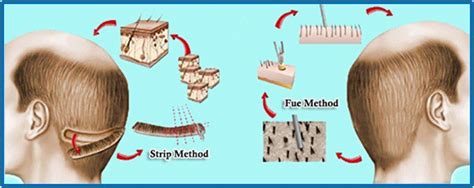What are the different types of hair transplants?
When it comes to combating hair loss and restoring natural hair growth, hair transplants have become increasingly popular. But what exactly are the different types of hair transplants available? Let’s explore the various methods used in hair transplantation and understand the key differences between them.
Follicular Unit Transplant (FUT): The strip harvesting technique
In FUT, a strip of skin containing hair follicles is surgically removed from the donor area, typically the back of the head. The strip is then dissected into smaller grafts, each containing one to four hair follicles. These grafts are then transplanted into the recipient area where hair growth is desired. This technique allows for the transplantation of a large number of grafts in a single session, making it an efficient option for individuals with extensive hair loss.
Follicular Unit Extraction (FUE): Minimally invasive extraction method
FUE is a minimally invasive hair transplantation method. Instead of removing a strip of skin, individual hair follicles are extracted directly from the donor area using a specialized tool. This method leaves tiny, virtually undetectable scars and allows for a quicker recovery time compared to FUT. FUE is suitable for patients who prefer a less invasive procedure and have a limited amount of donor hair available.
Robotic Hair Transplant: Advanced technology in hair restoration
Robotic hair transplant, also known as robotic follicular unit extraction (RFUE), utilizes artificial intelligence and robotic technologies to perform precise and accurate hair follicle extraction. The system identifies and extracts the most robust and healthy hair follicles, minimizing human error. Robotic hair transplant provides a high success rate and is an ideal option for those seeking advanced technology for their hair restoration journey.
Scalp Micro-pigmentation (SMP): Non-surgical alternative for hair loss
SMP is a non-surgical technique that creates an illusion of hair follicles by applying tiny pigment dots to the scalp. It is commonly used to create the appearance of a buzz cut or simulate a shaven head. SMP can be used to enhance the results of a hair transplant or as a standalone option for individuals who prefer a non-invasive solution. It is a versatile and effective method for restoring the look of a full head of hair.
Platelet-Rich Plasma (PRP) Therapy: Stimulating hair growth naturally
PRP therapy involves using the patient’s own blood to stimulate hair growth in areas experiencing thinning or miniaturization. The blood is processed to extract platelet-rich plasma, which is then injected into the scalp. PRP contains growth factors that promote hair follicle health and stimulate natural hair growth. This method can be used in conjunction with other hair transplant procedures for enhanced results.
Direct Hair Implantation (DHI): Direct extraction and implantation technique
DHI is a hair transplantation technique that combines the principles of FUE with a specialized implantation tool. In DHI, hair follicles are extracted individually using a micro-punch, and then immediately implanted into the recipient area using a Choi Implanter Pen. This direct extraction and implantation technique ensures minimal handling of the grafts and offers high survival rates. DHI provides natural-looking results and is suitable for both men and women.
Comparing the pros and cons of different hair transplant methods
Each hair transplant method has its own advantages and considerations. While FUT allows for the transplantation of a large number of grafts in a single session, FUE offers a minimally invasive approach and leaves less noticeable scars. Robotic hair transplant utilizes advanced technology for precise extraction, while SMP provides a non-surgical alternative and PRP therapy stimulates natural hair growth. DHI combines the benefits of FUE and direct implantation technique. It is essential to consult with a qualified hair transplant specialist to determine the most suitable method based on individual needs and preferences.
In conclusion, understanding the different types of hair transplants is crucial when contemplating a hair restoration procedure. Each method offers its own unique advantages and it is essential to consult with a qualified professional to determine the most suitable approach for achieving the desired results. Whether opting for FUT, FUE, robotic hair transplant, SMP, PRP therapy, DHI, or any other technique, a successful hair transplant can help restore confidence and bring back a full head of hair.
Follicular Unit Transplant (FUT): The strip harvesting technique
A follicular unit transplant (FUT), also known as the strip harvesting technique, is one of the different types of hair transplants available for those experiencing hair loss or baldness. This method involves removing a strip of hair-bearing skin from the donor area, typically the back or sides of the scalp, and then dissecting it into individual follicular units for transplantation.
The strip of scalp that is removed during the FUT procedure is carefully selected to ensure it contains healthy hair follicles. This strip is usually small and discreetly placed, allowing the surrounding hair to conceal any scarring that may occur. Once the strip is removed, the surgeon sutures the donor area, which typically results in a thin linear scar that can be easily hidden with longer hair.
The dissected follicular units are then meticulously implanted into tiny incisions made in the recipient area, which is the area of the scalp that requires hair restoration. The surgeon strategically places the follicular units to ensure a natural-looking hairline and optimal coverage. The implanted hair follicles will eventually grow new hair, filling in the areas of thinning or baldness.
When considering the FUT technique, there are several advantages and disadvantages to keep in mind. On the positive side, FUT allows for the transplantation of a large number of hair follicles in a single session, making it an efficient option for those requiring extensive hair restoration. The strip harvesting technique also typically results in a higher yield of hair follicles compared to other methods.
However, FUT does have some drawbacks. The main disadvantage is the linear scar that may be left in the donor area. While this scar can often be concealed with longer hair, it may be more visible if the individual prefers shorter hairstyles. Additionally, the recovery period for FUT can be longer compared to other hair transplant methods, as the donor area needs time to heal.
In conclusion, the follicular unit transplant (FUT) technique, also known as the strip harvesting technique, offers an efficient and effective solution for hair loss and baldness. While it may have some limitations, including the linear scar and longer recovery period, FUT remains a popular choice among individuals looking for a permanent and natural-looking hair restoration option.
Follicular Unit Extraction (FUE): Minimally invasive extraction method
When it comes to hair transplants, there are different methods available depending on the needs and preferences of the individual. One popular technique is Follicular Unit Extraction (FUE), which is known for being a minimally invasive extraction method. FUE is a modern approach to hair restoration that offers several advantages over traditional methods.
Unlike the strip harvesting technique used in Follicular Unit Transplant (FUT), FUE involves individually extracting hair follicles from the donor area. This means that there is no need for a linear incision or stitches, resulting in minimal scarring. The extraction process is done using micro punches, typically ranging from 0.6mm to 1.0mm in diameter, to carefully remove the follicles one by one.
Another advantage of FUE is that it allows for a more natural-looking result. Since the hair follicles are extracted individually, the surgeon has greater control over the placement and direction of the transplanted hair. This precision ensures that the hairline appears seamless and blends in with the existing hair.
- Minimally invasive: The micro punches used in FUE result in tiny incisions that heal quickly and leave minimal scarring.
- Natural-looking results: The individual extraction of hair follicles allows for precise placement, resulting in a seamless and natural hairline.
- Less downtime: FUE typically has a quicker recovery time compared to other hair transplant methods, allowing individuals to resume their normal activities sooner.
| Pros | Cons |
|---|---|
| Minimally invasive | Higher cost compared to FUT |
| Natural-looking results | May require multiple sessions for extensive hair loss |
| Quicker recovery time | Possibility of transection or damage to the follicles |
It is important to note that while FUE offers many advantages, it may not be the ideal choice for everyone. Those with extensive hair loss may require multiple sessions to achieve the desired result. Additionally, the cost of FUE can be higher compared to FUT due to the meticulous nature of the procedure.
In conclusion, Follicular Unit Extraction (FUE) is a minimally invasive extraction method that offers several benefits for individuals seeking hair restoration. With its precise extraction and natural-looking results, FUE has become a popular choice in the field of hair transplants. However, it is essential to consult with a qualified professional to determine the most suitable approach based on individual circumstances and goals.
Robotic Hair Transplant: Advanced technology in hair restoration
The Robotic Hair Transplant is an advanced technology in the field of hair restoration. It offers a more precise and efficient method of extracting and implanting hair follicles compared to traditional hair transplant techniques.
One of the key advantages of the Robotic Hair Transplant is its ability to accurately select and harvest healthy hair follicles for transplantation. The robotic system uses advanced imaging technology to identify and map out the best quality hair follicles, ensuring a higher success rate and more natural-looking results.
In addition to its precision, the robotic system also offers a minimally invasive approach to hair restoration. The robotic arm, guided by a skilled surgeon, can extract individual hair follicles with minimal damage to the surrounding scalp. This leads to faster healing times and less scarring compared to traditional transplantation methods.
The use of robotics in hair transplantation also reduces the risk of human error. The robotic system is programmed to follow a predetermined set of parameters, ensuring consistent and accurate results. This eliminates the variability that can occur with manual techniques and allows for a more efficient procedure.
- High precision
- Minimally invasive
- Reduced risk of human error
Overall, the Robotic Hair Transplant represents a significant advancement in hair restoration technology. Its ability to select and transplant hair follicles with great precision, coupled with its minimally invasive approach, makes it an attractive option for individuals seeking a permanent solution to hair loss. Although the procedure may be more expensive than traditional methods, the benefits and superior results achieved with robotic technology make it a worthwhile investment for many individuals.
| Advantages | Disadvantages |
|---|---|
| High precision: The robotic system can accurately select and harvest healthy hair follicles for transplantation. | Higher cost: The Robotic Hair Transplant may be more expensive compared to traditional methods. |
| Minimally invasive: The robotic arm can extract individual hair follicles with minimal damage to the scalp, leading to faster healing times and less scarring. | Equipment limitations: Availability of robotic technology may be limited in some clinics or regions. |
| Reduced risk of human error: The robotic system follows a predetermined set of parameters, ensuring consistent and accurate results. | Operator expertise: Skilled surgeons are required to operate and guide the robotic system effectively. |
Scalp Micro-pigmentation (SMP): Non-surgical alternative for hair loss
Scalp Micro-pigmentation (SMP) is a non-surgical alternative for hair loss that has gained popularity in recent years. This innovative technique involves the application of micro-dots of pigment to the scalp, creating the illusion of a full head of hair. SMP is particularly beneficial for individuals who have experienced extensive hair loss or those who prefer a low-maintenance solution to their hair loss woes.
One of the key advantages of SMP is its ability to achieve natural-looking results. The pigmentation process involves carefully mapping out the hairline and matching the color and density of the existing hair follicles. This attention to detail ensures a seamless blend between the pigmented dots and the natural hair, giving the impression of a closely-cropped haircut. The precision and artistry involved in SMP are crucial in creating a realistic and aesthetically pleasing result.
Another advantage of SMP is its versatility. It can be used to address a variety of hair loss concerns, including receding hairlines, thinning hair, and even complete baldness. SMP can also be employed to camouflage scars from previous hair transplant procedures or other scalp injuries. Additionally, this technique is suitable for both men and women, making it an inclusive option for individuals seeking to enhance their hair density.
- Scalp Micro-pigmentation (SMP) offers a non-surgical alternative for hair loss.
- SMP creates the illusion of a full head of hair through the application of micro-dots of pigment.
- The process ensures natural-looking results by matching the color and density of existing hair.
- SMP can address various hair loss concerns and camouflage scars from previous procedures.
- This technique is suitable for both men and women.
| Advantages of SMP | Disadvantages of SMP |
|---|---|
| – Achieves natural-looking results | – Not a permanent solution |
| – Versatile in addressing various hair loss concerns | – Requires touch-ups over time |
| – Camouflages scars and imperfections | – May cause slight discomfort during the procedure |
While SMP offers numerous benefits, it is important to consider its limitations. Unlike surgical hair transplant procedures, SMP is not a permanent solution. Over time, the pigment may fade and require touch-ups to maintain its original appearance. Some individuals may also experience slight discomfort during the treatment process, although this is typically well-tolerated.
In conclusion, Scalp Micro-pigmentation (SMP) provides a compelling non-surgical alternative for individuals experiencing hair loss. With its ability to achieve natural-looking results and address various hair loss concerns, SMP offers a versatile option for both men and women. However, it is essential to recognize that SMP is not a permanent solution and may require periodic touch-ups. Overall, SMP represents an innovative and accessible approach to restoring confidence and enhancing the appearance of a full head of hair.
Platelet-Rich Plasma (PRP) Therapy: Stimulating hair growth naturally
Platelet-Rich Plasma (PRP) Therapy is a cutting-edge hair restoration treatment that stimulates natural hair growth. It is gaining popularity as a non-surgical alternative for individuals experiencing hair loss. PRP Therapy involves extracting a small amount of the patient’s blood, processing it to isolate the plasma rich in platelets, and then injecting it into the scalp. This treatment utilizes the healing properties of platelets to promote hair growth and rejuvenate dormant hair follicles.
One of the significant advantages of PRP Therapy is that it is a natural and safe procedure. The patient’s own blood is used, which eliminates the risk of allergic or adverse reactions. The platelets in the plasma are known to contain numerous growth factors that aid in tissue repair and regeneration. When injected into the scalp, these growth factors stimulate the activity of hair follicles, leading to the growth of thicker and healthier hair.
PRP Therapy is suitable for both men and women experiencing different types of hair loss. Whether it is androgenic alopecia, alopecia areata, or even hair thinning due to environmental factors, PRP can be an effective solution. However, it is important to note that PRP Therapy may not be suitable for everyone. A thorough consultation with a qualified hair restoration specialist is necessary to determine if this treatment is appropriate for an individual’s specific condition.
| Pros of PRP Therapy | Cons of PRP Therapy |
|---|---|
|
|
Platelet-Rich Plasma (PRP) Therapy is an exciting advancement in the field of hair restoration. It offers a natural and safe solution for individuals seeking to stimulate hair growth without undergoing surgery. By harnessing the healing power of platelets and their growth factors, PRP Therapy can help rejuvenate dormant hair follicles and promote the growth of thicker and healthier hair. However, it is important to consult with a qualified specialist to determine if PRP Therapy is the right option for your specific hair loss condition.
Direct Hair Implantation (DHI): Direct extraction and implantation technique
Direct Hair Implantation (DHI) is a revolutionary hair restoration technique that offers a direct extraction and implantation process. Unlike other hair transplant methods, DHI ensures precise and natural-looking results. With the help of advanced technology and skilled surgeons, DHI has become a popular choice for individuals seeking a permanent solution to their hair loss problems.
One of the main advantages of DHI is its direct extraction method. This means that hair follicles are extracted one by one from the donor area and immediately implanted into the recipient area. The process is meticulously performed to maintain the integrity of the follicles and ensure their survival. By minimizing the time follicles are out of the body, DHI maximizes the chances of successful implantation and healthy hair growth.
Furthermore, DHI utilizes a special tool called a Choi Implanter, which allows for precise and controlled implantation of hair follicles. The Choi Implanter has a hollow needle with a diameter equal to the size of the extracted follicle. It creates a tiny incision in the recipient area and gently places the follicle, ensuring the correct angle and direction for natural hair growth. This meticulous implantation technique contributes to the overall natural appearance of the transplanted hair.
When comparing DHI with other hair transplant methods, there are several factors to consider. Firstly, DHI does not require any incisions or stitches in the recipient area, resulting in faster healing and minimal scarring. Additionally, the risk of damage to the hair follicles is reduced due to the precise implantation process. The natural density and direction of the transplanted hair make it virtually undetectable, providing a natural-looking result.
In summary, Direct Hair Implantation (DHI) offers individuals a direct extraction and implantation technique for hair restoration. With the use of advanced technology and precise implantation methods, DHI ensures natural-looking results and fast healing. If you’re considering a hair transplant, it’s worth exploring the benefits of DHI and consulting with a skilled surgeon to determine if this technique is the right choice for you.
Comparing the pros and cons of different hair transplant methods
When considering hair transplant options, it’s important to weigh the pros and cons of each method. Different hair transplant methods have emerged over the years, each with its own unique benefits and drawbacks. In this blog post, we will compare the pros and cons of various hair transplant methods, helping you make an informed decision about which option may be best for you.
Follicular Unit Transplant (FUT): The strip harvesting technique
The FUT method involves removing a small strip of skin from the donor area, typically at the back of the head, and dissecting it into individual grafts. This technique allows for a large number of grafts to be transplanted in a single session, making it suitable for patients requiring extensive hair restoration. However, it does leave a linear scar at the donor site, which may be visible if you prefer short hairstyles.
Follicular Unit Extraction (FUE): Minimally invasive extraction method
FUE is a minimally invasive hair transplant method that involves individually extracting follicular units from the donor area using a special punching tool. One of the main advantages of FUE is that it leaves no linear scar, making it ideal for those who prefer to keep their hair short. However, it is a time-consuming procedure, and the number of grafts that can be transplanted in a single session is limited compared to FUT.
Robotic Hair Transplant: Advanced technology in hair restoration
Robotic hair transplant involves the use of an automated system to extract and transplant hair follicles. It offers precise and consistent results, as the robot is programmed to identify and extract healthy follicles. The main advantage of this method is reduced human error, resulting in minimal damage to the donor area and faster healing. However, the high cost of robotic hair transplant may be a deterrent for some patients.
Scalp Micro-pigmentation (SMP): Non-surgical alternative for hair loss
SMP is a non-surgical hair loss solution that uses micro-needles to deposit pigment into the scalp, replicating the appearance of hair follicles. It is an effective option for those who prefer a shaved head look or have limited donor hair for transplantation. SMP requires multiple sessions for optimal results and may not be suitable for individuals with extensive hair loss.
Platelet-Rich Plasma (PRP) Therapy: Stimulating hair growth naturally
PRP therapy involves injecting concentrated platelets from your own blood into the scalp to stimulate hair growth. It is a non-invasive procedure with minimal side effects, providing natural-looking results. However, multiple sessions are often required, and the effectiveness of PRP therapy may vary from person to person.
Direct Hair Implantation (DHI): Direct extraction and implantation technique
DHI is a hair transplant technique that involves extracting and implanting individual hair follicles in a single motion, without the need for recipients sites or incisions. This minimizes the time the grafts are outside the body, enhancing their survival rate. DHI allows for precise placement of grafts, but it is a time-consuming procedure and may not be suitable for large-scale transplants.
In conclusion, each hair transplant method has its own advantages and disadvantages. Understanding the pros and cons of different techniques can help you choose the most suitable option based on your specific needs, hair loss pattern, and desired outcomes. Consulting with a qualified hair restoration specialist is crucial to determine which method is best for you, taking into consideration factors such as donor hair availability, budget, and desired hairstyle.
Frequently Asked Questions
Question 1: What is a Follicular Unit Transplant (FUT) and how does it work?
A Follicular Unit Transplant (FUT) is a hair transplant method that involves the strip harvesting technique, where a strip of hair is removed from the donor area and divided into smaller grafts. These grafts are then implanted into the balding or thinning areas of the scalp.
Question 2: How is a Follicular Unit Extraction (FUE) hair transplant performed?
A Follicular Unit Extraction (FUE) is a minimally invasive hair transplant method. It involves individually extracting hair follicles from the donor area using a small punch instrument. These follicles are then carefully implanted in the recipient area to restore hair growth.
Question 3: What are the benefits of a Robotic Hair Transplant?
A Robotic Hair Transplant utilizes advanced technology to assist in hair restoration. It offers precise and efficient graft extraction and implantation, minimizing human error. The robotic system can also analyze and select the best quality hair grafts for transplant, ensuring natural-looking results.
Question 4: How does Scalp Micro-pigmentation (SMP) work as a non-surgical alternative for hair loss?
Scalp Micro-pigmentation (SMP) is a non-surgical cosmetic procedure that involves tattooing microdots of pigment on the scalp to create the illusion of hair follicles. This technique can be used to simulate a shaved head look or to enhance the appearance of thinning hair by adding density.
Question 5: How does Platelet-Rich Plasma (PRP) Therapy stimulate natural hair growth?
Platelet-Rich Plasma (PRP) Therapy is a treatment that involves extracting a patient’s own blood, processing it to concentrate the platelets, and then injecting the platelet-rich plasma into the scalp. The growth factors present in PRP help stimulate the hair follicles, promoting hair growth and overall hair health.
Question 6: What is Direct Hair Implantation (DHI) and how is it different from other hair transplant methods?
Direct Hair Implantation (DHI) is a hair transplant technique that involves the direct extraction and implantation of hair follicles using a specialized pen-like instrument. This method allows for precise control over the depth, angle, and direction of hair follicle placement, resulting in natural-looking and long-lasting results.
Question 7: What factors should be considered when comparing different hair transplant methods?
When comparing hair transplant methods, it is important to consider factors such as the invasiveness of the procedure, the recovery time, the naturalness of the results, the expertise required for performing the technique, and the cost. Each individual’s specific needs and preferences should also be taken into account.





